By Charlie Grotevant
As someone who underwent successful ileostomy surgery in 1983 followed by immediate membership in the Kankakee, Illinois chapter of United Ostomy Associations (UOA), my history is long. My wife Joyce and I attended several UOA National Conferences during the 1990s and 2000s, making friends from around the country.
In 2014, I began a Memoir entitled The Healthy Years chronicling my life beginning with 1983. It consists of 162 pages with nearly 60,000 words and photos. There is an abundance of information regarding UOAA, taken from emails, writeups in Affiliated Support Group (ASG) newsletters, notes written shortly following many of the events, etc. This narrative is gleaned from my Memoirs.

Like our symbol, the Phoenix, UOAA rises from the Ashes of UOA
During the UOA years Ken and Linda Aukett served, during different intervals, as President of UOA, including a term for Ken as President of the International Ostomy Association.
Linda led advocacy efforts with elected and appointed government officials and interacted with other health-related support and research organizations.
My visibility with UOA became nationwide when I was the recipient of the 18th annual Great Comebacks Award in 2002. At that time the program was financially sponsored by Convatec and co-sponsored by Crohn’s & Colitis Foundation. UOAA became an additional co-sponsor in 2006.
During March of 2005, it became apparent UOA was planning to dissolve due to financial shortcomings. Contributing to this decision was the withdrawal of the Canadian chapters of UOA to become the Ostomy Canada national organization several years prior. UOA announced it would cease operations on September 30, 2005 after 43 years of providing essential services.
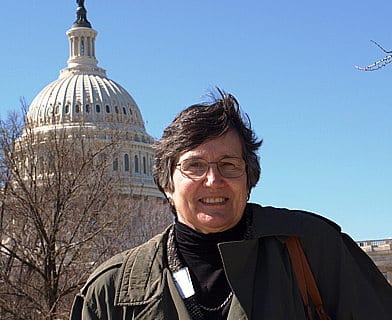
UOAA C0-Founder Linda Aukett at the Capitol in Washington, D.C. while serving as President of DDNC (Digestive Diseases National Coalition).
Ken and Linda Aukett were determined that a national ostomy support organization was essential for the continued support and education of approximately 750,000 Americans, their caregivers, and patients considering or needing ostomy surgery. Pursuing advocacy issues, as had been done with UOA, was equally important.
The Auketts began creating a Steering Committee to establish the successor organization. It was to become an organization of individual Affiliated Support Groups (ASGs) operating under the umbrella of the national organization. ASGs would collect dues from individual members to maintain their respective local groups and would send ASG dues to UOAA.
UOA had served as a national organization with several hundred Chapters throughout the country. UOA published the Ostomy Quarterly magazine and sponsored a Youth Rally camp as well many other functions on the national level.
Mary Jane Wolfe had a lead role in setting up the new organization, helping come up with the name United Ostomy Associations of America (UOAA), but did not want to be on the Steering Committee. She recommended me to Ken who put the “hard sell” on this busy Illinois farmer to be the 7th member. Mary Jane was also a major force in the prior UOA Rally, leading by example from her wheelchair.
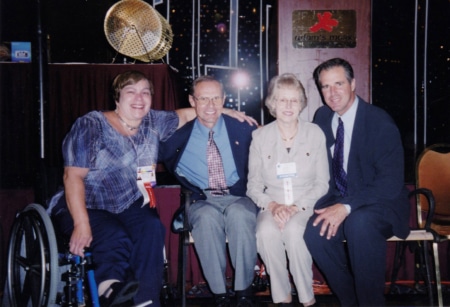
Charlie and Joyce, center, with Mary Jane Wolfe, left, and NFL legend and ostomy advocate Rolf Benirschke, right, at a National Conference.
The Steering Committee consisted of Ken as President, Julielynn Gibbons as Vice President, Ginnie Kasten as Secretary, Dave Rudzin as Treasurer, Ron Titlebaum and myself as Directors. Linda Aukett was officially recognized as the Advocacy Chair. George Salamy was named as Chair of the Trustees.
A major role incorporating UOAA, securing 50 (c3) tax-exempt status, and assisting with writing the Constitution of UOAA was filled by Philadelphia lawyer, Sheldon Sokol, working pro bono, for whom we are forever grateful.
Bob Baumel, who had served as webmaster for UOA, became and expanded the webmaster duties with UOAA. Thank you, Bob for all you have done and continue to do.
Ian Settlemire, who had served as Editor of Ostomy Quarterly, created The Phoenix magazine, the official publication of the UOAA. A free copy was sent to each former Ostomy Quarterly subscriber in December of 2005. Subscription fees to The Phoenix have been an important source of revenue for the UOAA for the past 20 years.
The final UOA National Conference was held August 3rd-6th in Anaheim, California with UOAA given time to tell of the new organization and respond to questions and concerns.
The Steering Committee members were given assignments to meet with vendors, UOA officials, medical professionals, and health service providers. In addition to the explanatory sessions, I was to meet with Dave Johnson, VP of Convatec, telling the goals of UOAA and requesting financial support. I was well acquainted with Dave because of the Great Comebacks Program and subsequent publicity events. He pledged a significant monetary commitment to UOAA.
Outhouse to White House
As a farm boy, who was 9 ½ years old before we had running water and indoor plumbing, I have truthfully gone from the outhouse to the White House. The White House adventure was arranged by Convatec at the time of the 2007 Great Comebacks National Awards in Washington, DC, with separate Congressional lobbying calls on the agenda, carried out the next day.
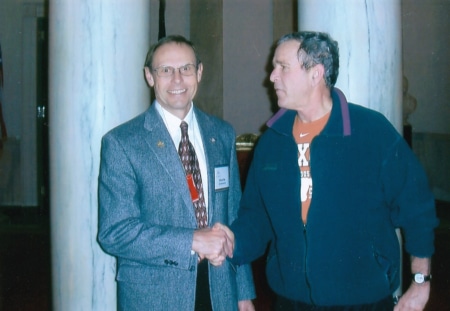
Charlie with President George W. Bush at the White House in 2007.
A White House after hours visit was hosted by Marvin Bush, younger brother of President George W. Bush. Marvin is a member of the 5P Club, People who Poop or Pee in a Plastic Pouch, a survivor of IBD.
Marvin needed to leave prior to the arranged time for the mini bus to take us back to the hotel. Then the President arrived on the scene, and this group of 13 had an interesting 25 minutes of non-political chit-chat.
Even though Convatec has undergone ownership changes, I remain forever grateful for all they have done for us and other recipients of the Great Comebacks Award.
Early Years of UOAA
On October 1st, 2005, UOAA became an official legal entity and the Steering Committee became the initial Membership Board of Directors, a bare-bones organization. In later years after multiple staff positions were created, the designation MBoD became Board of Directors.
Linda arranged for the UOA toll-free number to be transferred to UOAA, with each Board member to take the calls one day a week. Lots of calls on some of my assigned days into an answering machine. I responded as soon as possible. Some wanted genuine information and encouragement, but a few wanted a shoulder to cry on or complain.
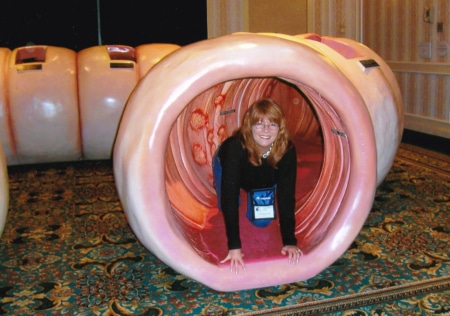
Coco, the Colossal Colon at the 2007 UOAA National Conference. It had been previously featured on The Today Show and UOAA volunteers appeared with it on an episode of Shipping Wars.
I was also happy to server as Liaison to Youth Rally, which became separate nonprofit organization. I became a volunteer counselor in 2006 and continued as a counselor through 2012 when my hearing was deteriorating badly and I considered myself a liability rather than an asset to the Rally. Those weeklong camps at various college campuses were the most rewarding and most tiring weeks of those years. I continue to support Youth Rally financially.
2006 was a busy year for UOAA and others on the MBoD. Early that year, Joan McGorry was hired as Office Administrator to work out of her home. This eliminated the weekly telephone response sessions on the part of those of us on the MBoD.
In February, I received a call from a WOC nurse in southern Illinois telling of a young lady being denied insurance coverage for ostomy supplies. I consulted Linda Aukett regarding this issue and received guidance.
A few weeks later, I was invited by Convatec to speak at a national sales conference in New Jersey. At the sales conference, I met with the Convatec Director of Health Economics and Reimbursement and a separate healthcare consultant to discuss ways to proceed with the Illinois reimbursement issue.
A month later, following the testimony of the aggrieved ostomy patient to the Illinois Insurance Committee, I presented testimony and supporting evidence. An insurance lobbyist in his lawyer language quickly denied the need for mandatory coverage.
The Chair of the Committee appointed a sub-committee to study the issue. Net result, SB 2444, an amendment to the Illinois Insurance Code, passed requiring coverage for ostomy supplies, although allowing deductibles to occur. A victory for UOAA!
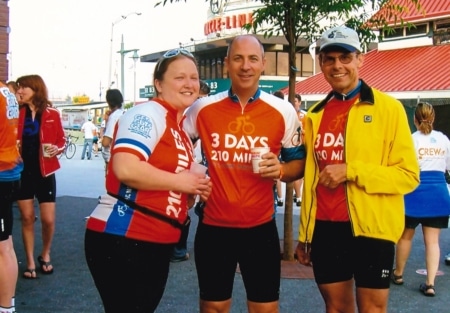
Julielynn Gibbons, Bob Baker and Charlie as UOAA reps at the 2007 GYGIG 3-day bike ride.
Also in 2006, UOAA became a co-sponsor and beneficiary of Get Your Guts In Gear (GYGIG), a 3-day bike ride fundraiser for UOAA, Crohn’s & Colitis Foundation, The Colon Club, and other organizations focused on IBD, colorectal cancer, and the needs of ostomy patients. This was the third year of the GYGIG event. In each of the first two years I rode, UOAA received $60,000.
In 2007, UOAA had additions with Mary Jane Wolfe, Kristin Knipp, Lynne Kramer and LeeAnn Barcus joining the MBoD.
A Support Group Ambassador Program was also initiated with the goal of surfacing volunteers to act throughout their respective states and regions in efforts to gain more ASGs and increase membership.
On a personal level, because of three winter months on the Gulf Coast of Florida, I visited and spoke to as many as a dozen ostomy support groups, facilitating changes in leadership and bringing one major hospital into UOAA. I did the same in Illinois.
2008 brought Bob Baker onto the UOAA MBoD. I was acquainted with Bob because of his Regional Great Comebacks Award. We also shared a GYGIG ride in 2007. Bob has now rejoined the UOAA Board.
One of the basic foundations of UOAA is the need for constant and competent advocacy with elected and appointed officials.
Susan Burns also joined the MBoD that year followed by Jim Bob Murray the next year. Millie Parker then came onto MBoD in another year or two as did Justin Blum. Many more followed.
At the end of 2008, I exited the MBoD because the hearing deficit was reducing my effectiveness. I continued as UOAA Ambassador and remain willing to call on ASGs and individuals when asked. I also continue leading the Kankakee ASG.
As I conclude this narrative, I praise Ken and Linda Aukett for all they have done and what Ken continues to do with years of total involvement in the greater ostomy community. They became the heart and soul of UOA, UOAA, and the International Ostomy Association, traveling to every continent except Antarctica.
Linda also served as the UOAA representative on the Digestive Diseases National Coalition (DDNC) Board and was later Chaired that organization, linking 23 national organizations together in advocating for common interests.
Evidence of Linda’s advocacy efforts was shown in 2011 when Ken and I accompanied a former US Senate staffer who was rudely examined by TSA personnel as he prepared to board a flight.
A few years prior, UOAA led the effort in getting the Blue Notification Card accepted by TSA as proper notification of special medical conditions and the need for the screening to be done in a discreet manner. Even so, continued insufficient training of some TSA personnel continued to result in occasional major mistreatments.
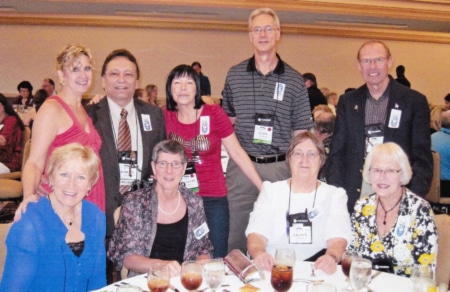
2013 UOAA National Conference in Jacksonville, FL.
A meeting, arranged by the insider using his personal friendship with the President of the Senate, occurred in the TSA office. TSA Director John Pistole, TSA Legal Counsel Jackson, and the Director of Operations were with us for an hour to meet and discuss the problems still arising during TSA screenings.
During our self-introductions, when Ken identified himself, the Legal Counsel asked of Linda. Jackson, quickly stated to the effect that ‘I have had many conversations with Linda and we continue to work on solutions for the problems at hand. Yes, the name Aukett brought instant recognition.
One of the greatest losses to our ostomy community was the passing of Linda in 2013 due to cancer. Her knowledge and abilities, whether with Youth Rally, with UOA and UOAA functions, and especially with advocacy efforts on Capitol Hill where she was known by elected and appointed officials is beyond comparison in my opinion.
Thank you, Ken and Linda for your ‘over and above’ efforts throughout many years of helping others.
Be the Future
As for my thoughts for the future of UOAA. One of the basic foundations of UOAA is the need for constant and competent advocacy with elected and appointed officials. This is more so than ever before due to the political divisiveness threatening all aspects of everyone’s life. UOAA has a wonderful Advocacy Program with many ways to get involved.
With all the inaccurate information floating through all media, including websites, blogs, etc., it is critical for UOAA to be the voice of accuracy. This will require increased determination on the part of everyone associated with UOAA to be the voice on the local level as well as nationally. Yes, UOAA can go forward if enough concerned people become UOAA members and come forward to volunteer and assist in meeting the challenges before us.
I invite others to share historical UOAA memories and let me know if everything I have shared is accurate. We hope to see many of you in Orlando for the 2025 National Conference where we will take time to celebrate 20 Years of UOAA!
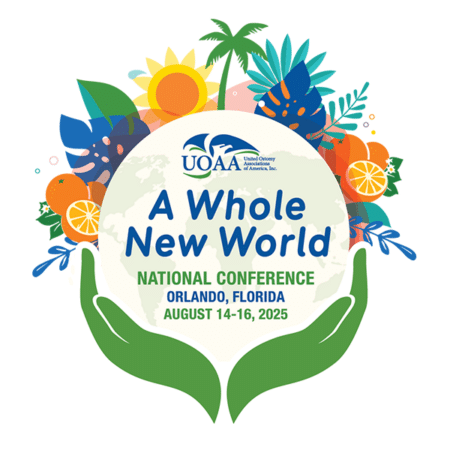
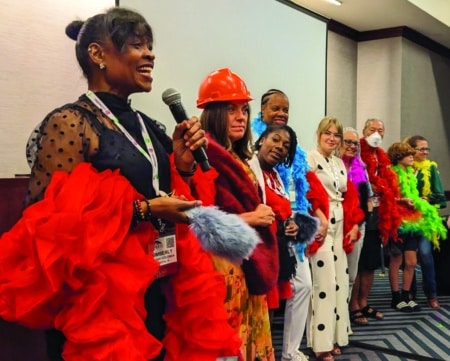
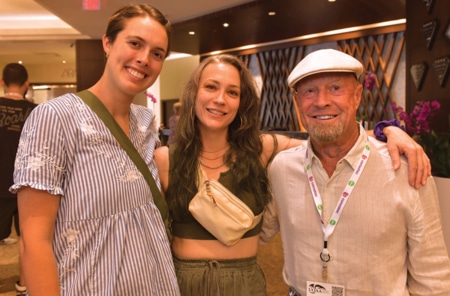 40 vendors will be there to visit with you and share any new products they are offering, services they provide, clothing and accessories available in today’s market, and much more. We’ll be serving a complimentary boxed lunch on Friday before the Exhibit Hall closes at 1pm for you to enjoy.
40 vendors will be there to visit with you and share any new products they are offering, services they provide, clothing and accessories available in today’s market, and much more. We’ll be serving a complimentary boxed lunch on Friday before the Exhibit Hall closes at 1pm for you to enjoy.
 UOAA’s 9th National Conference. Stay a few days earlier or after the conference and enjoy what the Resort has to offer with family and/or friends.
UOAA’s 9th National Conference. Stay a few days earlier or after the conference and enjoy what the Resort has to offer with family and/or friends.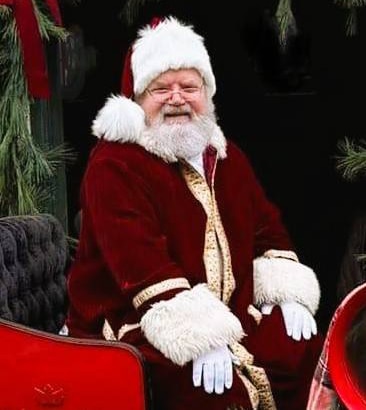

 signing onto ten different letters that were sent to Congress many with positive results and we had several open action alerts on our advocacy platform supporting Federal legislation. We also continue to advocate with the Access and Care Coalition in our efforts with the Medical Directors from the Centers of Medicare and Medicaid Services (CMS) to make improvements to the ostomy policies and processes in particular for those beneficiaries who medically need greater quantities of products than what is allowable under the current policy. We won’t stop until this is resolved. Another example has been challenges with
signing onto ten different letters that were sent to Congress many with positive results and we had several open action alerts on our advocacy platform supporting Federal legislation. We also continue to advocate with the Access and Care Coalition in our efforts with the Medical Directors from the Centers of Medicare and Medicaid Services (CMS) to make improvements to the ostomy policies and processes in particular for those beneficiaries who medically need greater quantities of products than what is allowable under the current policy. We won’t stop until this is resolved. Another example has been challenges with 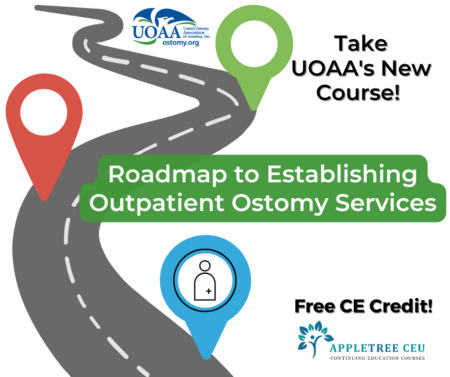
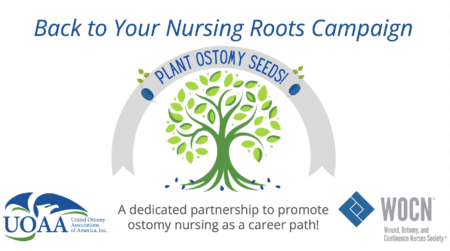


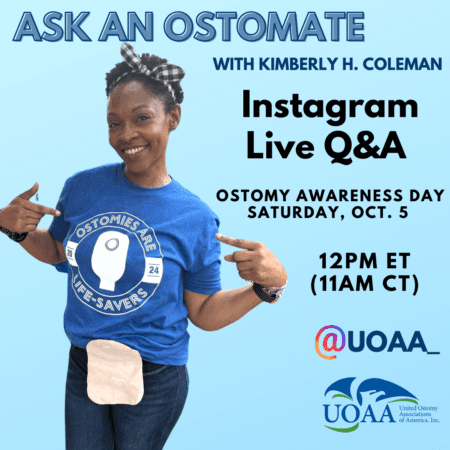

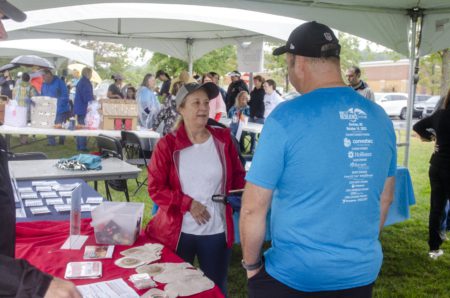 questions and show off supplies at the events nationwide with the exception of Alabama. Check your race bags for a special sticker and magnet as well. Coloplast is also hosting an Ostomy 5k event for staff on the campus of their Minneapolis headquarters.
questions and show off supplies at the events nationwide with the exception of Alabama. Check your race bags for a special sticker and magnet as well. Coloplast is also hosting an Ostomy 5k event for staff on the campus of their Minneapolis headquarters.

